Trends and challenges in a changing landscape: A survey of facilities management
Facilities management: the essential service
Facilities management (FM) is a thread that runs through the fabric of society. Working in multiple and varied disciplines, from property maintenance, security and energy efficiency to cleaning, catering and workplace design – and many more besides – FM professionals make sure that the places where people work, learn, play and live are safe, comfortable, productive and sustainable.
Numerous organisations in the public, private and third sectors depend on FM, including central and local government, health, education, financial services, transport, utilities, technology and manufacturing.
The UK’s FM market is one of the most competitive in the world, representing 8% of the country’s gross domestic product and employing around 10% of its workforce. But, like all industries, FM has experienced unprecedented challenges because of the COVID-19 virus and the measures imposed to prevent its spread. 2020 saw a market value decrease of around 6% in UK facilities management outsourcing. At the same time, technological innovations in the FM sector present significant opportunities for growth, and further investment in technology will help FM improve its overall business.
This report represents the findings from a survey of FM professionals working in the UK and across the world. It provides a snapshot of how the sector is responding to the many challenges it faces, and its plans for future development.
Surveying the FM landscape
This is a significant moment to consider the state of FM. The sector has been at the heart of rapid and far-reaching workplace responses to the COVID-19 pandemic. During the first wave, there was a sharp rise in demand for cleaning, hygiene and waste management services in key sectors such as healthcare and education. Even as many businesses closed their doors, there was continued need for security and essential maintenance, and many facilities managers were also charged with looking after the health and safety of colleagues working remotely. Ensuring a safe return to work has presented a further set of challenges for facilities managers, from conducting risk assessments and keeping workplaces clean to managing shift patterns and maintaining a healthy indoor environment.
The pandemic has also accelerated trends that were already affecting the FM industry. Levels of remote working have greatly increased, and there has been much greater dependence on technology for communication, management and operational functions.
Taking these developments into account, Idox invited FM professionals to tell us about their views, priorities and experiences. Our survey included questions about the FM services themselves, the environments in which FM is operating, and the challenges, opportunities and uncertainties now facing the industry. We were also interested in how organisations are actively using technology to support FM, and how they see their future requirements.
The survey results
Profiling FM professionals
FM professionals work in a very diverse range of industry sectors. This was reflected in the survey responses which came from people working in energy, leisure, health and social care, retail, education, housing, financial services, local government and media – to name just a few.
The survey also demonstrated the international nature of FM. While more than 90% of respondents’ organisations operate in the UK, there is also representation in Western Europe (26%) and North America (21%), with further operations in the Middle East, Central and Eastern Europe, South America and Africa.
The sizes of organisations in the survey were equally diverse, ranging from 1-49 employees (18%) to 5000+ employees (26%), while over a third (36%) have between 50-999 employees. As for FM teams themselves, the survey shows around half of respondents work in teams of one-ten people, while 21% have more than 51 FM colleagues.
Although FM professionals have been taking on additional responsibilities in recent years, managing property portfolios is still a substantial part of the job. Our survey found that around 23% of respondents manage between 100-500 thousand sq. ft. of space, while 20% manage up to 20,000 sq. ft. and a smaller number (8%) manage more than five million sq. ft. of space.
economy, and the impact is already being felt: global commercial property investment volume fell by 48% in the third quarter of 2020, leading to uncertainty about the amount of space organisations will retain in future.
Chart one: Number of employees within organisations
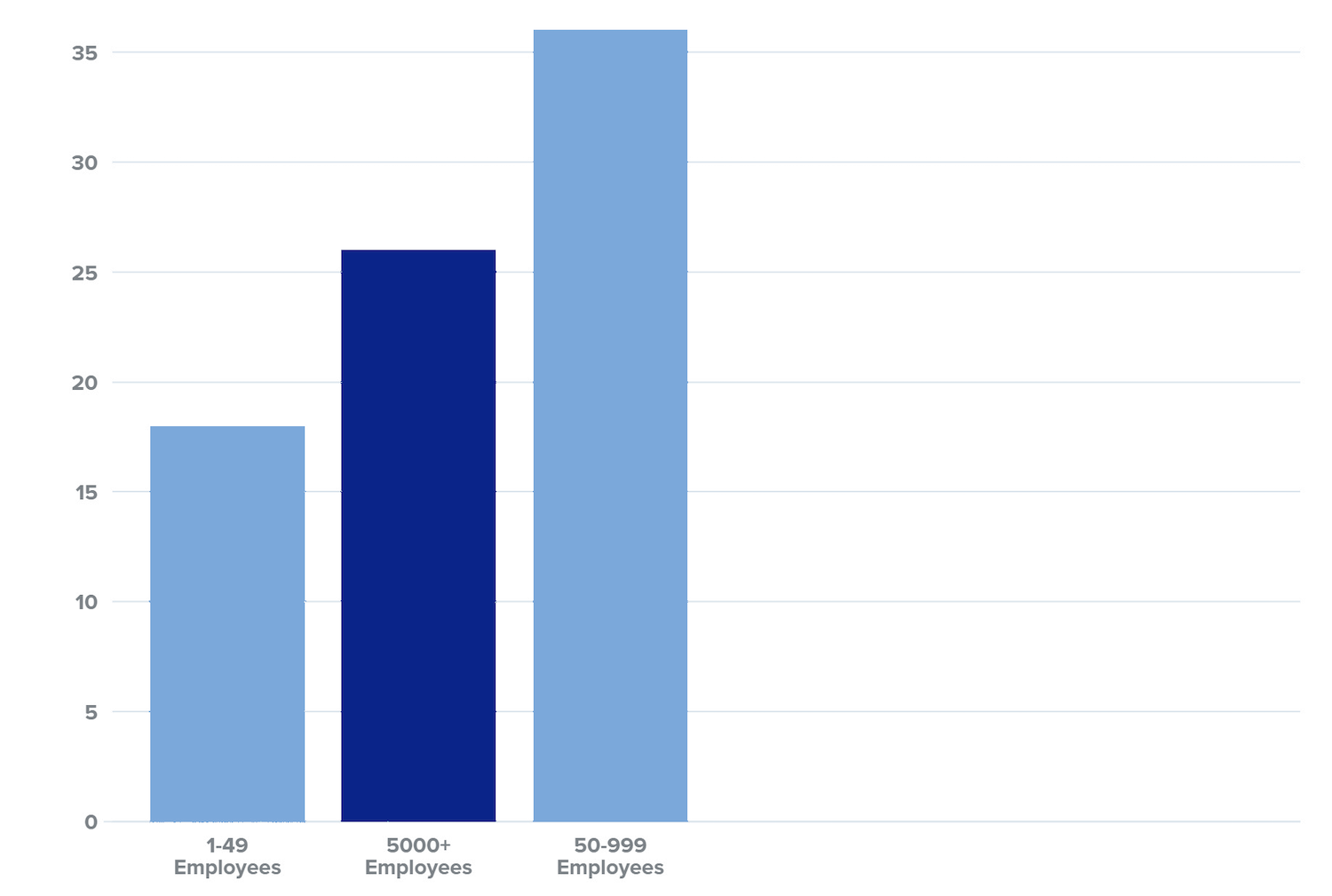
Concerns and trends: budgetary constraints and a redefined workplace
This has been a difficult period for many businesses, and one of the main aims of the survey was to assess FM professionals’ concerns about current trends, and how these might affect their work in the future.
Before the pandemic struck, the FM sector was already under pressure to perform at higher service levels with fewer resources. COVID-19 has added to those pressures, and our survey found that budget constraints was the number one concern among respondents (62%).
It came as no surprise to see more than half of respondents expressing concern about changes in work patterns, and a further third concerned about reduced demand for space. In little over a year, there has been a dramatic shift in the number of people working remotely, a step change which many employment observers believe will be long-lasting. This process has the potential to reshape the entire economy, and the impact is already being felt: global commercial property investment volume fell by 48% in the third quarter of 2020, leading to uncertainty about the amount of space organisations will retain in future.
Chart two: The main concern based on budget constraints
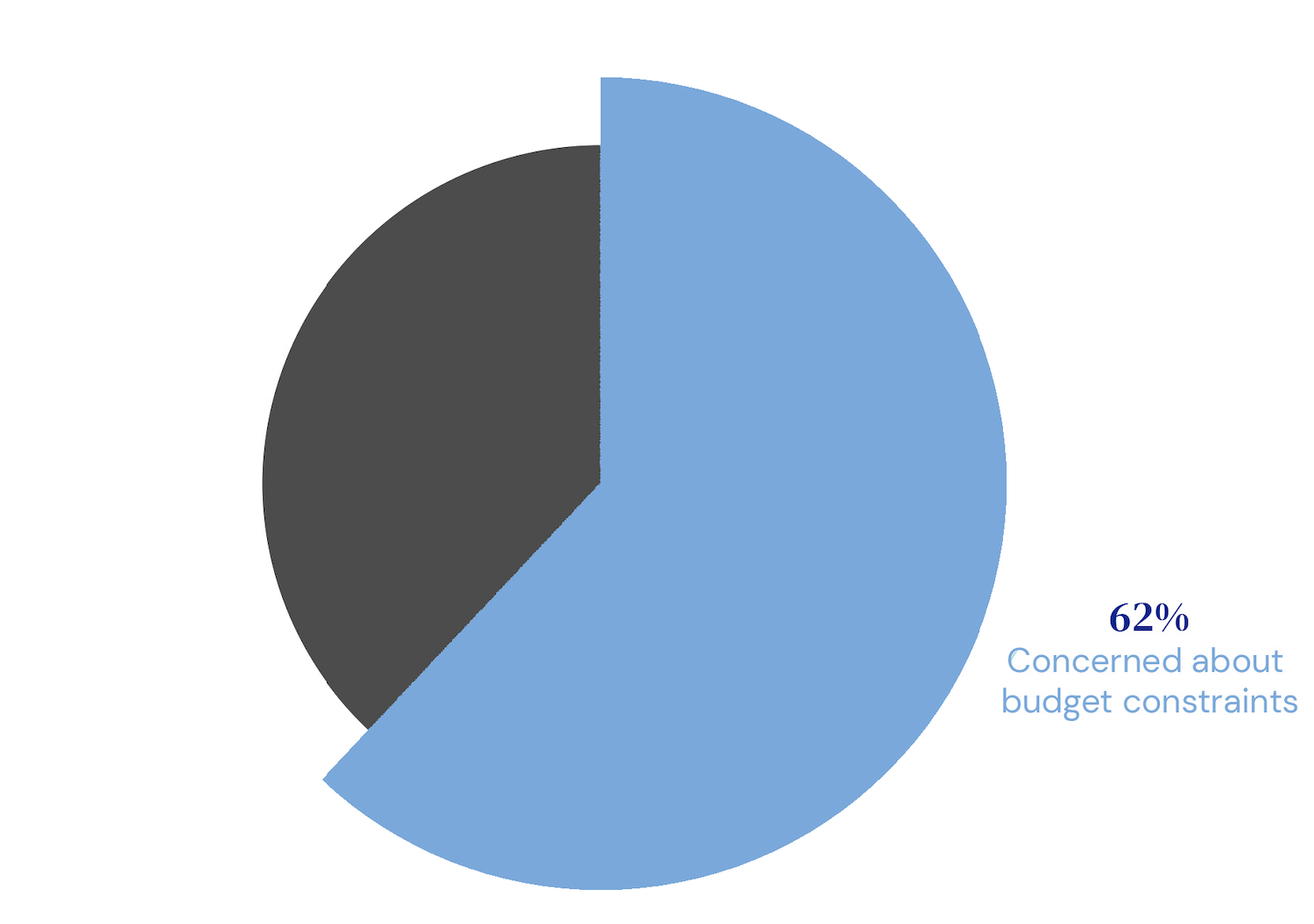
Concerns and trends: budgetary constraints and a redefined workplace
FM professionals also believe that further forces are at work that will affect their businesses in the coming twelve months. Asked to select the current trends that are expeced to have the greatest impact on FM within their organisations, most respondents chose “changes in frequency/density of office use” (25%), followed by “increased use of smart and touchless technology to manage physi-cal spaces” (22%) and “improving the workplace experience and company culture” (22%). Reduced budgets for offices (19%) and use of technology to manage property (17%) are also expected to im-pact FM professionals in the coming year. However, only 4% of facilities managers selected theuse of robots and automation as something likely to have the greatest impact on FM in their organisation in the next 12 months.
Chart three: The current trends that are expected to have the greatest impact on FM within their organisations
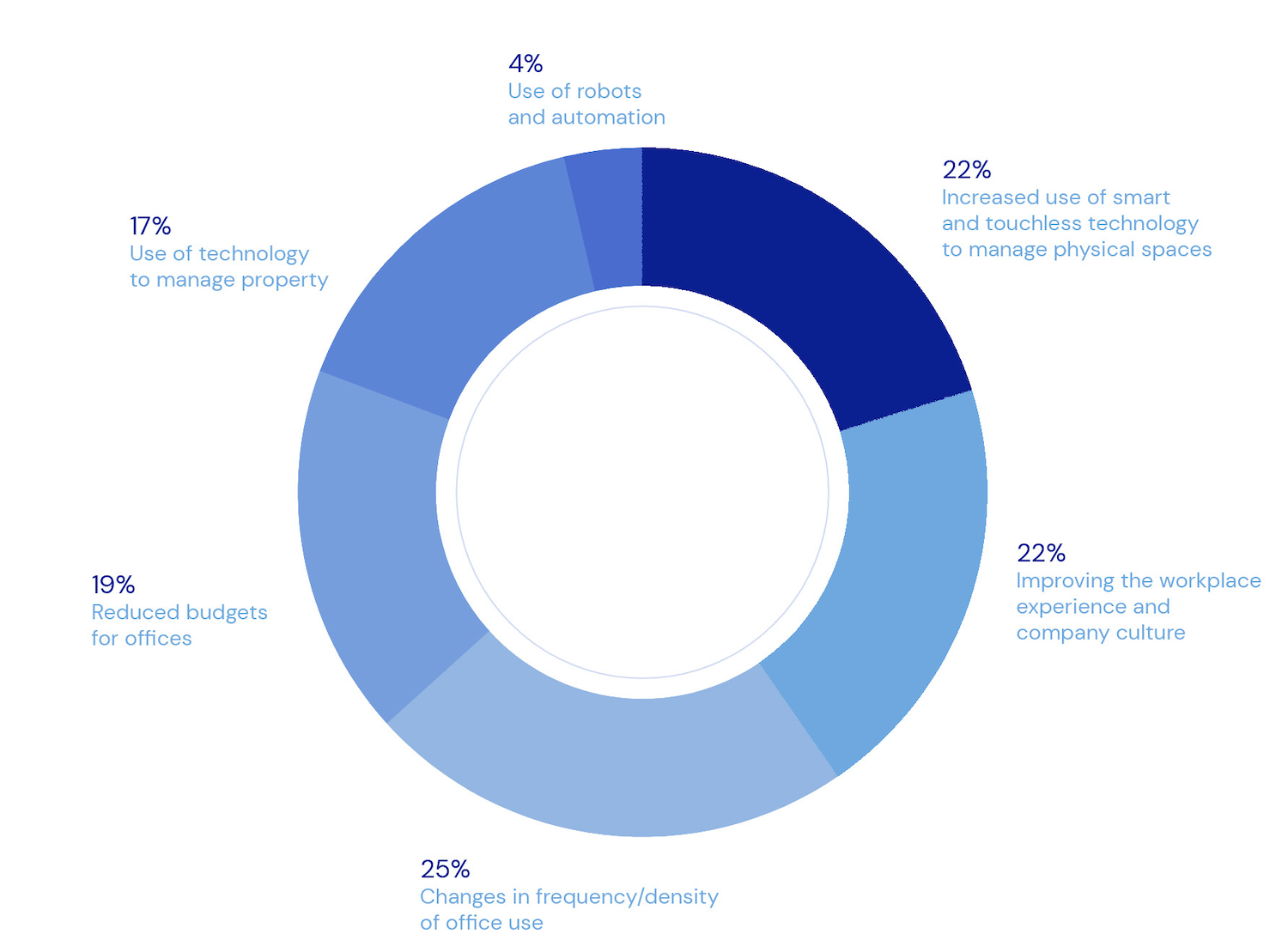
Present roles and future priorities
Effective facilities management is vital for an organisation’s strategic and operational objectives. By attending to record-keeping, ensuring compliance with regulations and maintaining assets, facilities managers can make the difference between success and failure.
At the same time, FM is evolving, and increasingly, the focus of facilities managers is shifting from asset management to supporting the health, wellbeing and comfort of employees, and from corrective to preventative and predictive strategies.
Our survey reflects the changing nature of FM. Asked to select which of their roles are most helpful in delivering their organisations’ strategic goals, almost 75% of respondents chose “increasing employee satisfaction and wellbeing” – the same number who selected“ controlling compliance risks”.
In recent years, businesses have become more conscious of their impact on the environment, and on society as a whole. The evidence suggests that by reducing their carbon footprint, sustainable businesses perform better and foster public support. There’s also a growing awareness that companies with sustainable business policies and practices attract and retain talented people who share the same values.
Chart four: Sustainable business policies and practices
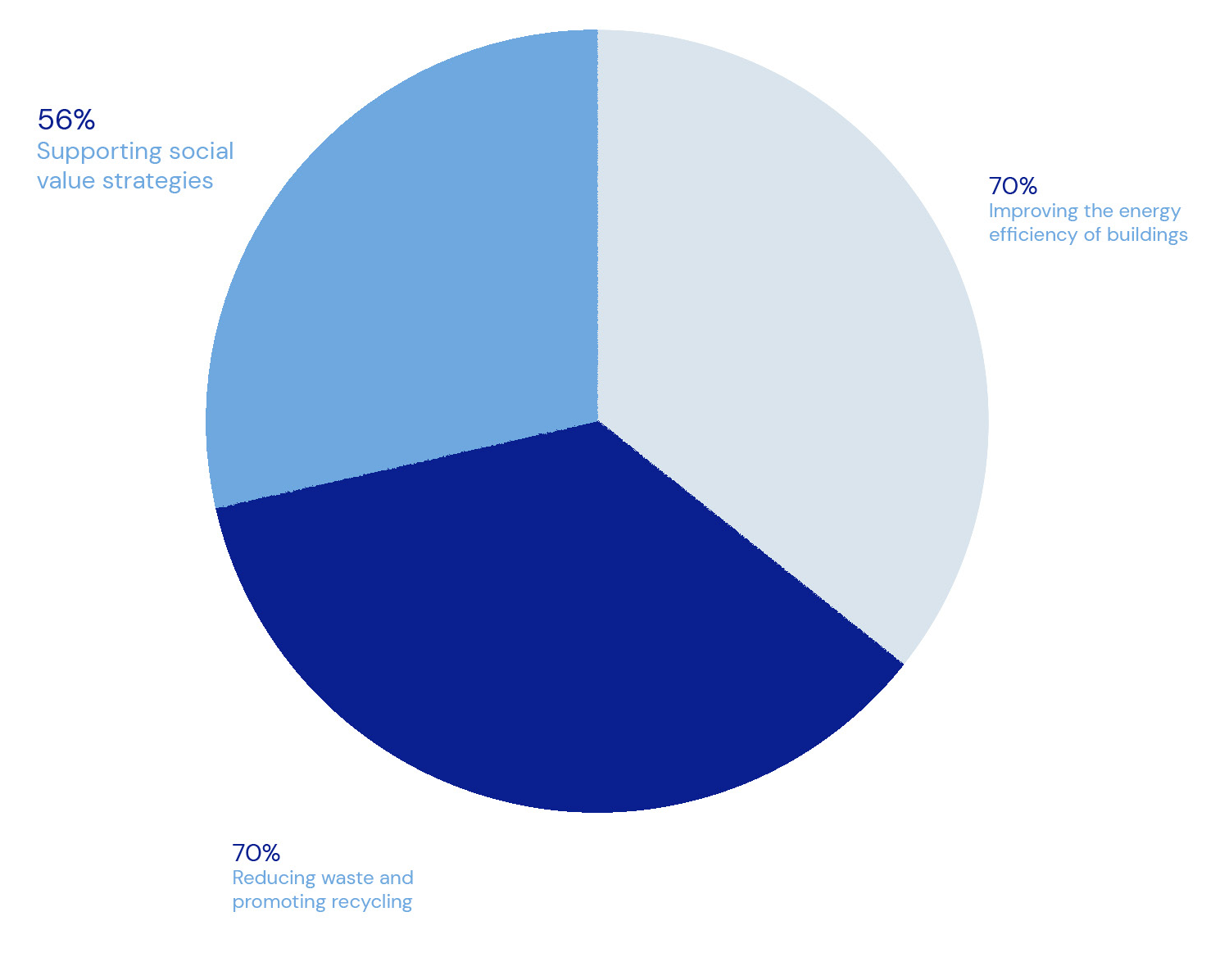
As a result, environmental management and supporting corporate social responsibility (CSR) policies have become key parts of the FM professional’s role. This is reflected in our survey results, in which respondents placed “improving the energy efficiency of buildings” (72%), “reducing waste and promoting recycling” (70%) and “supporting social value strategies” (56%) high on their list of strategically important responsibilities.
Investment plans and priorities for facilities managers in the coming year largely reflect the concerns highlighted elsewhere in the survey. From a selection of nine priority areas, 64% of respondents chose “flexible working”, followed by “supporting sustainability” (61%) and “asset tracking and management” (46%). However, FM professionals are also conscious of the need to prioritise workplace and relocation management (39%), facilities management software (39%) and real-time occupancy monitoring and building controls (37%).
“Facilities management now has evolved and I see tools like CAFM taking care of the full life cycle costs of all aspects of facilities management.”
“Facilities management now has evolved and I see tools like CAFM taking care of the full life cycle costs of all aspects of facilities management.”
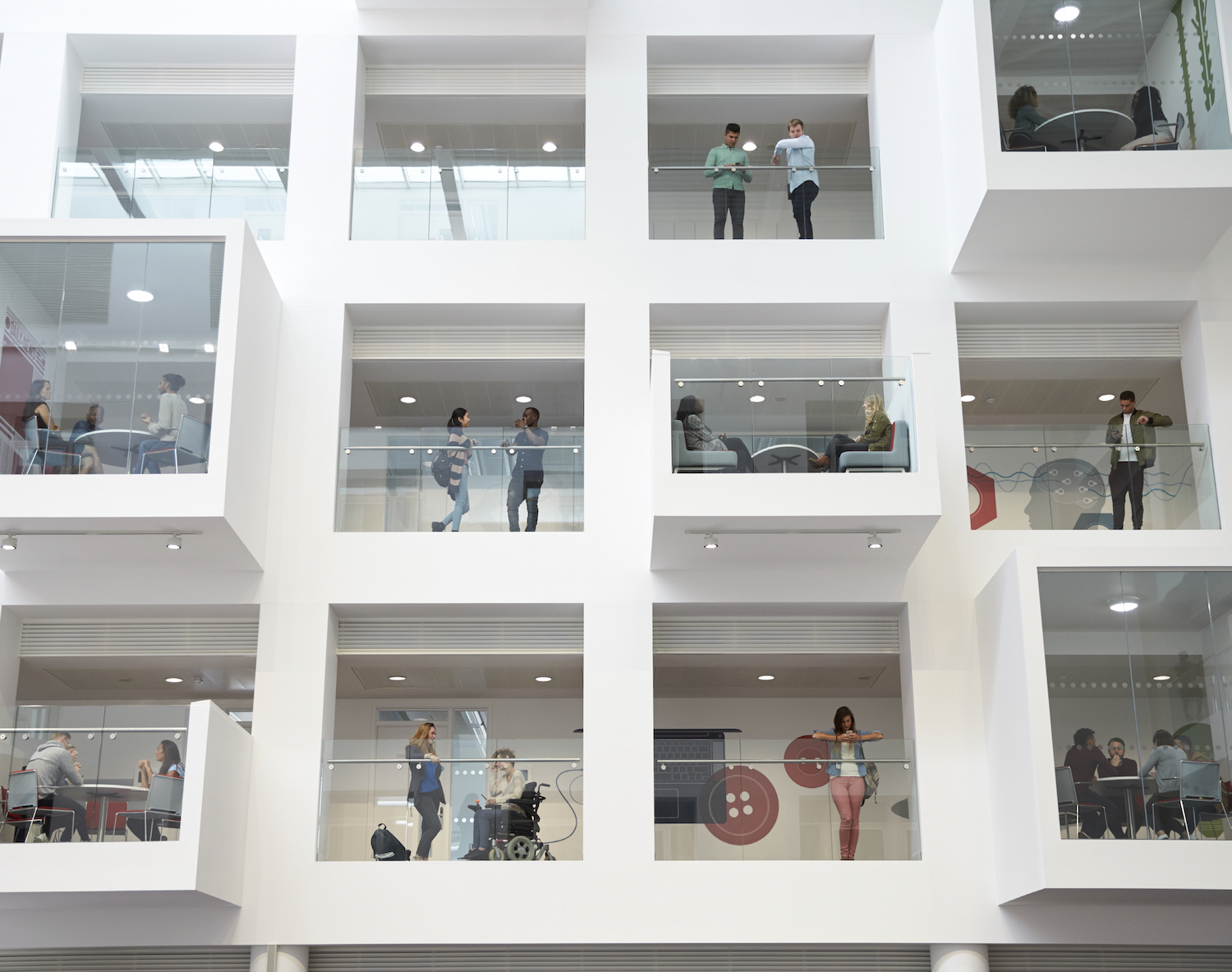
The technology imperative
Investing in the future
As the FM sector continues to evolve, technology has made fundamental shifts to cater to the varying needs of the industry. FM technology, such as computer-aided facilities management (CAFM) software has the capability to deliver significant benefits to businesses – from aiding strategic decision-making and ensuring compliance and health and safety, to helping drive costs down and improving data management and productivity.
Our survey shows that FM professionals are highly aware of the benefits of harnessing technology to support their work. Asked to rank the matters to be considered when considering investment in FM technology, the majority of respondents put three issues at the top: driving efficiency (68%); digital innovation (43%); and ensuring safety (40%). Other issues also scoring highly included saving money (39%), working more collaboratively (34%) and being able to adapt faster (20%).
In addition, some respondents identified further matters for consideration, including improved accessibility and management, the quality, functionality and interconnectivity of FM software, connecting a dispersed workforce, and financial constraints.
Chart five: Matters to be considered when considering investment in FM technology
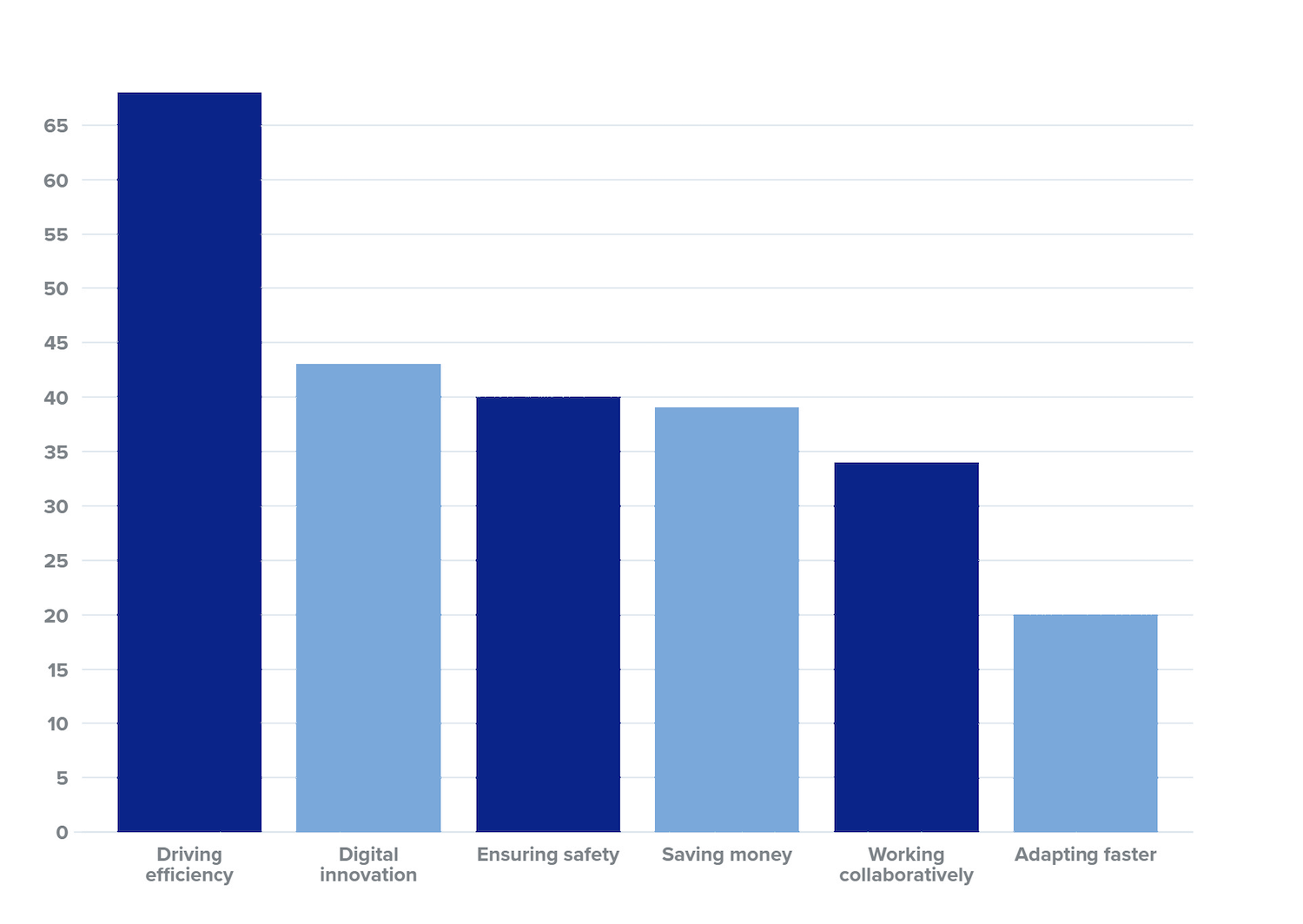
What our
customers say
“Facilities management now has evolved and I see tools like CAFM taking care of the full life cycle costs of all aspects of facilities management.”
“Updating processes need to be simplified and automated. Currently updating has a large cost or is overly technical on the users to perform this themselves. It should be as simple as clicking “update now”.”
“The future for facilities management is very promising, with changes every day. We are in a particularly advantageous position to show that the industry is always one step ahead.”
Technology priorities
When it comes to technology priorities within FM, the most important issue for respondents is security, with almost 80% of respondents ranking it as essential or a high priority. This is not surprising, especially since failure to comply with data regulations can put companies at risk of heavy fines.
Mobile working and cloud computing offer facilities managers greater flexibility and response speeds, and can substantially reduce operating costs. This is reflected in the survey results: mobile working is regarded as either essential or a high priority by 68% of respondents, while cloud-based solutions are regarded as essential or a high priority by 60%.
One emerging development that almost half of the survey respondents ranked as essential or a high priority is the integration of CAFM technology with Internet of Things (IoT) assets. Billions of physical devices are now connected to the internet, all collecting and sharing data. Connecting these objects and adding sensors to them can make devices smarter and more responsive.
It’s becoming clear to FM professionals that integrating CAFM and IoT applications can help to connect all the sectors of a business, simultaneously monitor multiple operations and harness new insights from the data provided by sensors. As our survey indicates, this is one area that facilities managers are watching closely.
At the other end of the scale, FM professionals seem to regard automation as one of the least importantn considerations. Fewer than a third of respondents identified automation as either an essential or a high priority. This is significant, as automated facilities management has enormous potential for improving facilities maintenance and supporting productivity.
However, our survey results echo the findings from a 2018 survey by the Institute of Faclitiies and Workplace Management (IFWM). That survey found that artificial intelligence and automation technologies such as machine learning, virtual reality and chat bots were predicted by FM professionals to have a less significant role than existing technologies over the next decade.
Existing software systems
We invited survey respondents to report which software systems they currently use for FM. A large number (62%) are still using spreadsheets to manage their facilities, although this may be alongside other systems. Spreadsheets are helpful for managing a relatively low number of tasks, but as the FM portfolio grows, the need to coordinate multiple issues requires a more sophisticated solution.
Many facilities managers are already modernising and strengthening their customer offer, deploying CAFM software such as Idox’s CAFM Explorer® solution to manage and consolidate information across all facets of their responsibilities. Managing everything from one, central system has the obvious advantages of scalability, resource and time efficiencies and data transparency and management. Our survey found that over half of respondents (53%) are using CAFM software.
In addition, 30% are using asset management software, while a small number of respondents have installed other systems, such as building information management (BIM) systems, in-house platforms, space booking systems, and Microsoft Sharepoint. 7% of respondents reported that they are not using any kind of software to manage their facilities.
The survey shone a light on the many ways in which FM professionals are applying CAFM software. Maintenance management (81%), planned preventative maintenance (73%) and reporting (60%) are the most commonly used CAFM applications, with work planning and mobile workforce management solutions also supporting FM operations.
It appears that most facilities managers have found that their existing CAFM software has risen to the challenges of the past year. 55% of respondents haven’t changed the way they use this software in the past twelve months, and over 60% have some level of confidence that their current FM software will meet present and future organisational needs.
Chart six and seven: Software systems currently in use for FM
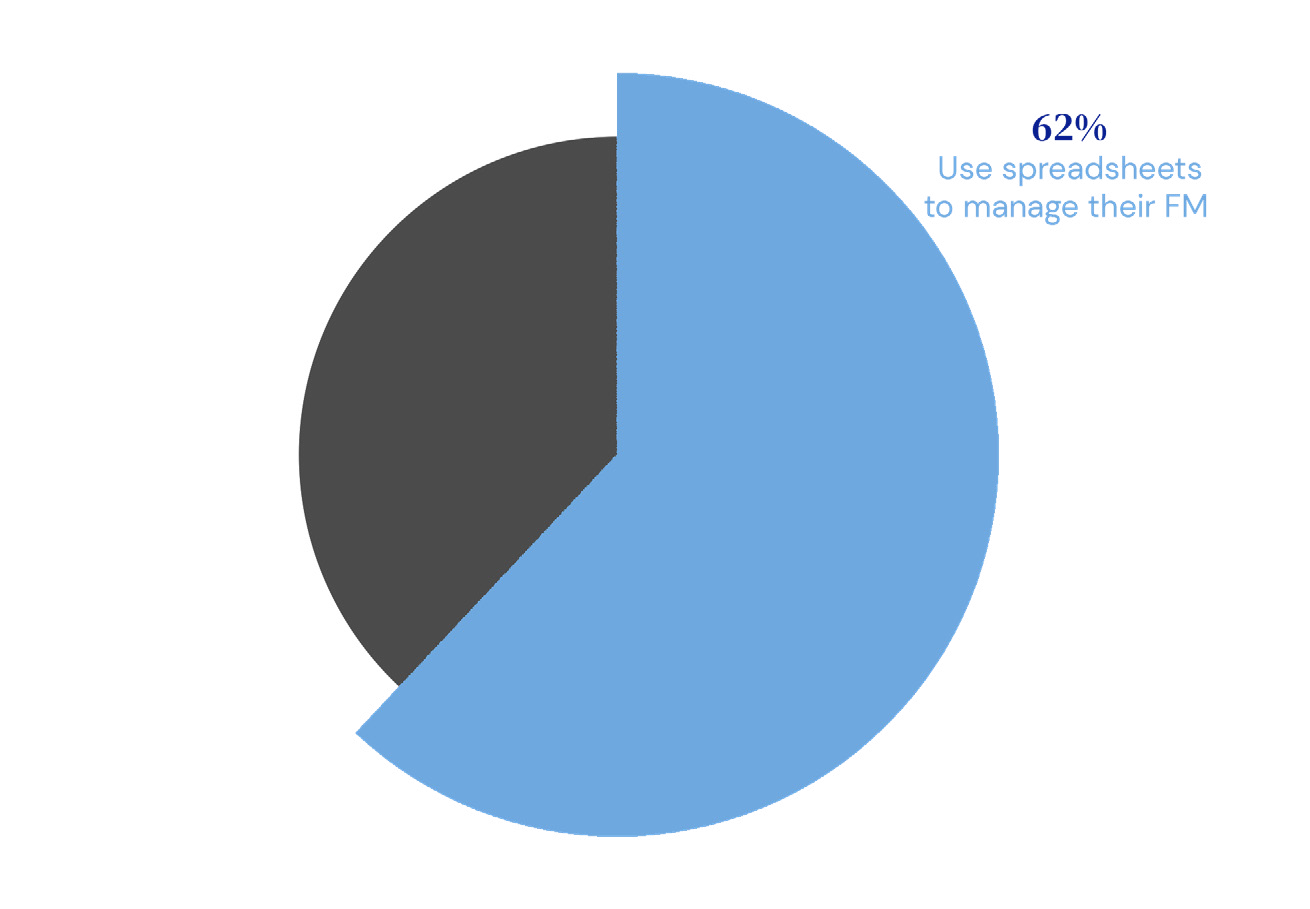
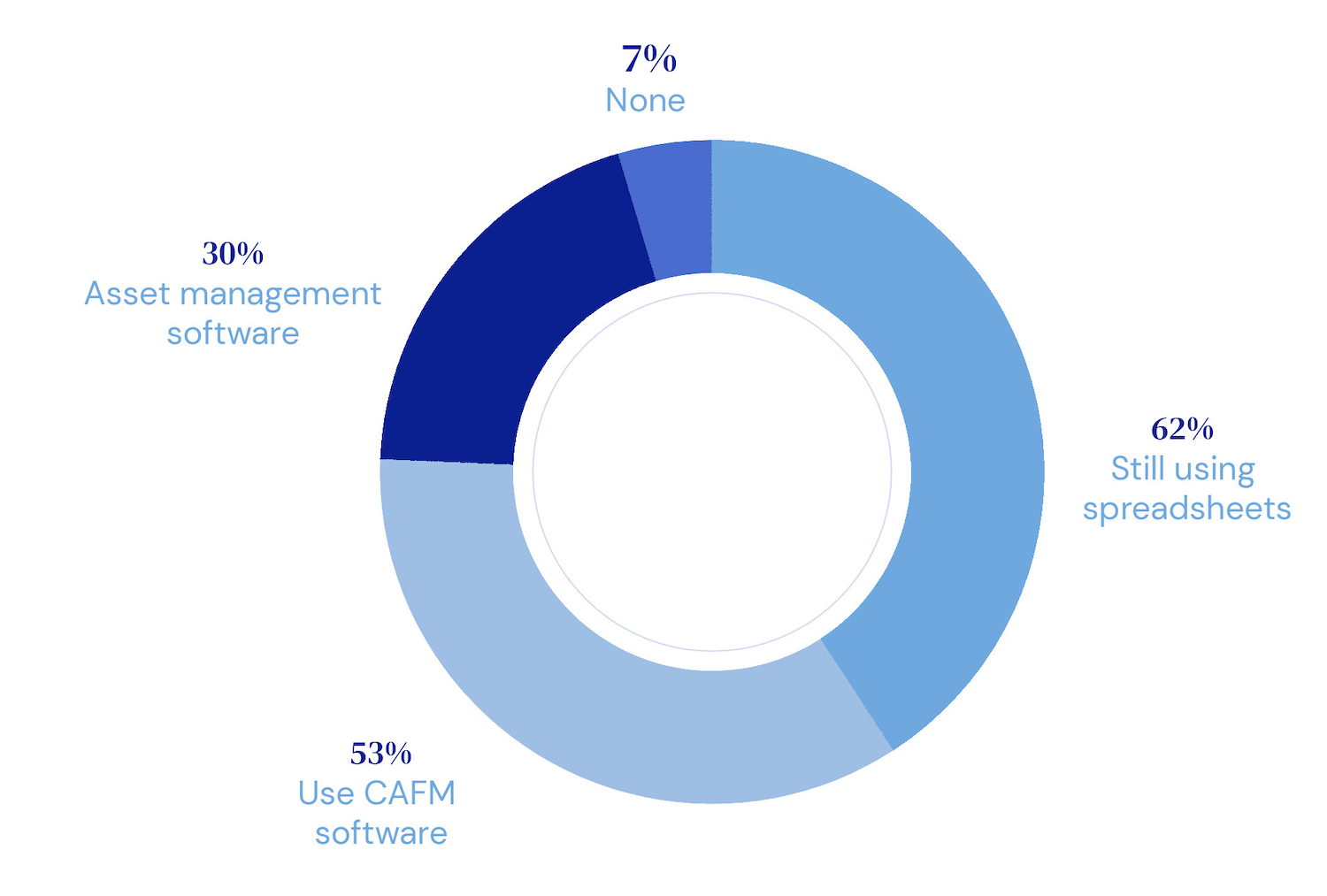
Reviewing the state of facilities management
The Economist magazine once described facilities management as a “sprawling, unseen, unglamorous industry that is hard to define and harder still to measure.” It’s true that the contribution made by FM professionals to the successful operation of an organisation is wide-ranging, frequently misunderstood and often underestimated. But this survey has demonstrated that it is possible to assess the state of the FM sector.
Taking the survey results as a whole, some key observations can be made:
COVID-19 pandemic
- The impact of COVID-19 is clearly looming over the FM industry, and there are particular concerns about changes in workplace behaviour and the wider potential economic consequences
- There is an expectation that flexible working, and working away from the office is here to stay
- The industry appears interested in CAFM software that helps FM professionals manage a safe, flexible workplace, and many want this software to be secure and work on mobile platforms, using cloud computing solutions
- There are opportunities for CAFM software to be at the core of a re-imagining of the workplace, although the industry is still not certain about what this will look like
Sustainability
- The results suggest that respondents are looking at how FM can help create more sustainable workplaces
- There is a focus on energy efficiency, and supporting sustainability across the sector
- There is a clear opportunity for CAFM software to take advantage of this trend
Digitisation and automation
- Respondents are keen on the digitisation of services, including the availability of CAFM on mobile devices, and they want to ensure the software is secure
- Automation is often hailed as the next big development in software, but respondents did not reflect this in their responses
- It appears that many facilities managers don’t yet view the use of automation and robotics as a significant development
- Automation is an area to watch, as it is often flagged in other industries as a springboard to generate efficiencies of the kind that our survey respondents highlighted as important
- Although, at least in the short-term, automation is not a high priority for FM professionals, the likelihood is it will grow over time, with considerable implications for the FM sector
COVID-19 has tested many businesses and their FM systems to the limit, and the experience of the pandemic will ensure that health and safety remains high on FM professionals’ agendas. But, as this survey indicates, facilities managers are still facing up to the pre-COVID challenges of doing more with less, demonstrating value-for-money, improving sustainability, and keeping up with technological change.
The world of work may be changing fast, and FM is changing with it. But ultimately, the profession exists, as it always has, to contribute to the delivery of strategic and corporate objectives, and to provide a safe and efficient working environment. The biggest challenge for the facilities managers of today and tomorrow will be to ensure that they can maintain this role while adapting to a workplace that is continually being redefined.
CAFM Explorer®: a vital part of the FM professional’s toolkit
As an all-in-one solution, CAFM Explorer® has the potential to offer all the functionality facilities managers need in a single tool, with the ability to scale based on need and grow in line with an organisation.
From one, consolidated platform, CAFM Explorer® offers a comprehensive range of tools, from Planned Preventative Maintenance and Asset Tracking, through to Space Management, Help Desk, Property Management and Cost Control.
Businesses are hungry for data about the performance of the workplace and how it can be made to perform better. CAFM Explorer® enables a real time view of operations via customised web dashboards and streamlines reporting through export of data to third party systems.
CAFM Explorer® is available as an on-premise or cloud-based solution, and has a proven track record for improving FM services and generating savings.
CAFM Explorer® is a comprehensive range of modules in one package, including:
- Asset register to give a 360 degree view of all your assets
- Cost control to centrally track purchasing, invoicing and financial data
- Maintenance management to issue alerts, work orders and track activity against SLAs
- Room and resource booking to easily manage shared resources
- Mobile workforce management to track, manage and support engineers
- Stock control to monitor usage, automate reordering and more
- Work planner to respond quickly to requests, using calendar and reporting tools
- Dashboard and reports for a real-time view of operations
- Support service for installation, migration and configuration of your system




